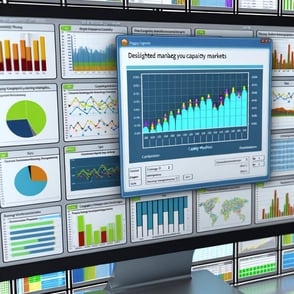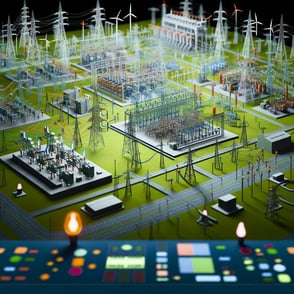Intraday Continuous Market
The intraday continuous market allows real-time electricity trading on the delivery day, letting participants instantly adjust supply and demand.
What is the Intraday Continuous Market?
The intraday continuous market is a platform where electricity is traded continuously on the day of delivery - unlike the Intraday Auctions Market where electricity is traded at specific times during the day. This allows for participants to manage their short-term fluctuations by making real-time adjustments to their electricity supply and demand. By providing this flexibility, the intraday market plays an important role in maintaining grid stability, as well as facilitating the integration of variable renewable energy sources.
The Purpose of the Intraday Continuous Market
The main purpose of the intraday continuous market is to provide a platform through which participants can make last-minute changes to their positions, as opposed to the Day-Ahead Market, where trading occurs one day before delivery. The ability to dynamically adjust prices and quantity means that participants can respond to unexpected changes in electricity demand or generation such as sudden weather changes affecting renewable energy production.
Across the electricity market, various players, including proprietary traders, utilities, industrial consumers, and large producers, need to continuously balance their electricity production and/or consumption. In contrast to futures markets, which help with long-term strategies, the intraday market caters to the most immediate requirements. For example, if a wind farm generates more electricity than anticipated, a trader can sell the excess on the intraday continuous market to align with the actual supply for that day. This market is essential for making continuous adjustments, allowing for efficient management of any last-minute supply and demand imbalances, increasing the reliability of the electricity grid.
Why Both Continuous and Auction Intraday Markets Exist
Having both continuous and auction intraday markets offers participants greater flexibility and a range of options to manage their electricity supply and demand. The continuous market allows for real-time, immediate adjustments, making it possible to respond instantly to unforeseen changes in production or consumption. This is particularly beneficial for participants who need to make quick decisions based on real-time data. On the other hand, the auction market provides structured opportunities at specific times, enabling participants to plan their trades in advance and strategically bid for electricity. This can lead to more stable and predictable pricing, as the market-clearing price is determined by aggregating supply and demand at set intervals. By offering both types of markets, the electricity system can accommodate a wide range of trading strategies and time frames, enhancing overall market efficiency and reliability.
How the Intraday Continuous Market Operates
The intraday continuous market typically functions through continuous trading on power exchanges like Etpa. It can also function via over-the-counter (OTC) contracts - contracts negotiated off-market directly between buyers and sellers.
The intraday continuous market opens in the afternoon of the previous day, allowing continuous trading for hourly, 30 minute, and 15 minute contracts. Participants submit buy and sell orders on trading platforms, specifying the electricity volume along with the prices they are prepared to accept. The trading platform matches buy and sell orders based on price and time. Orders that can be matched at the same price are executed, allowing for the continuous trading of electricity. The lead time - the time between order and delivery - has decreased drastically in previous years, further increasing the flexibility that the intraday continuous market creates.
Initiatives like the Cross-Border Intraday (XBID) market have expanded intraday trading beyond national borders, allowing participants to trade electricity across multiple European countries: Austria, Belgium, Denmark, Estonia, Finland, France, Germany, Latvia, Lithuania, the Netherlands, Norway, Portugal, Spain, and Sweden. This integration enhances market efficiency and responsiveness by enabling a broader pool of participants to contribute to grid stability.
Price Formation in the Intraday Continuous Market
The intraday continuous market provides real-time price signals, reflecting the current balance of supply and demand. The market makes use of the pay-as-bid principle, meaning that as soon as a sell trade is accepted by a buyer, the trade deal is completed. Each transaction is priced based on the buy/sell bids at the time of trade. As a result, intraday prices are not fixed, meaning it is common to have different prices for the same product throughout the day.

The Impact of the Intraday Continuous Market
The intraday continuous market plays several critical roles in the operation of the electricity system. The real-time adjustment capability provided by the market helps to prevent imbalances that could otherwise destabilize the electricity grid. By providing real-time supply and demand signals, the market also increases grid efficiency. Additionally, the intraday market helps manage price volatility by offering opportunities for participants to capitalize on real-time price movements.
Besides this, the market significantly supports the integration of renewable energy sources, which are inherently variable and often unpredictable. By allowing operators to sell excess generation or purchase shortfalls in real-time, the intraday market helps balance the grid despite fluctuations in renewable energy production. This balancing capability is crucial for maintaining grid stability and encouraging further growth in renewables as the share of intermittent renewable energy sources in the energy mix continues to increase.
Conclusion
The intraday continuous market serves as a crucial platform facilitating the continuous trading of electricity. This market is vital for maintaining grid stability and efficiency, especially in the face of unpredictable fluctuations in electricity generation and consumption. By enabling the integration of variable renewable energy sources, the intraday market supports the transition towards a more sustainable energy system. Its role in providing immediate responses to supply and demand changes ensures reliability and efficiency.
As the energy landscape continues to evolve, the importance of the intraday market will only grow, making it an indispensable component of modern electricity markets.
Glossary
- Bid: An offer to buy electricity at a specific price.
- Offer: An offer to sell electricity at a specific price.
- Day-Ahead Market: A market where electricity trading occurs one day before delivery, allowing participants to plan their electricity needs and production in advance.
- Continuous Trading: A trading process where participants can buy and sell electricity at any time during the market's operating hours, with transactions occurring as soon as a matching bid and offer are found.
- Grid Stability: The ability of the electricity grid to maintain a consistent and reliable supply of electricity, despite fluctuations in generation and consumption.
- Renewable Energy Sources: Energy sources that are naturally replenished, such as wind, solar, hydro, and biomass.
- Cross-Border Intraday (XBID) Market: An initiative that allows intraday trading of electricity across multiple European countries, enhancing market efficiency and responsiveness.
- Pay-as-Bid Principle: A pricing method where each transaction is priced based on the buy/sell bids at the time of trade, meaning the price paid matches the bid price at the time of the transaction.
- Over-the-Counter (OTC) Contracts: Contracts negotiated directly between buyers and sellers outside of formal trading platforms.
- Order Matching: The process of pairing buy and sell orders on a trading platform based on price and time.
- Price Volatility: The degree of variation in electricity prices over time, often influenced by supply and demand changes.
- Grid Efficiency: The effectiveness with which the electricity grid manages and distributes electricity to meet demand while minimizing waste and losses.
- Market Depth: The volume of bids and offers available at different price levels in the market
- Hourly Contracts: Contracts specifying the delivery of electricity for each hour within the same day.
- 30-Minute Contracts: Contracts specifying the delivery of electricity in 30-minute intervals within the same day.
- 15-Minute Contracts: Contracts specifying the delivery of electricity in 15-minute intervals within the same day.
.png?width=200&height=80&name=etpa-logo-color%20(1).png)











.png)
.png)
-1.png?width=250&height=100&name=etpa-logo-color%20(1)-1.png)